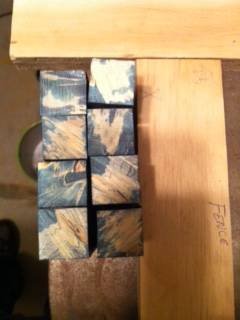Got my son a lathe last Christmas and he has been merrily turning away since then and has gotten very good. He has given many pens as gifts and sold a handful as well.
In an effort to earn some money, he's been out beating the bushes to get some orders for Christmas. Well, work started to pay off and he actually got his first order for 20 pens for corporate gifts!
Long story short, the request was for turquoise stabilized box elder. so we ordered the material from Penn State. It arrived the week before last and we set to work. About five of the blanks had very poor penetration of color, so had to go back to PS for resolution(not too happy so far, but that's another thread). Fast forward to starting to turn.
He's having about an 80% blow out rate on the wood. I thought maybe it was the glue, but we've tried three different glues at this point with the same results - 5 minute epoxy in the twin tube configuration, high quality boat building epoxy, and Gorilla Glue. Last round, I did the gluing myself in case it was something about his technique but the same results.
We've :
Tried multiple glues
Worked at multiple lathe speeds
Slowed his work down as much as possible
Changed to a brand new carbide blade
It's killing me to see him so frustrated. I'd have thrown something out the window by now, but he's being a real trooper. However, at this point, what was going to be a project with about $150-200 profit for him is now going to net him in the neighborhood of $10-$20 if we can't improve his success rate.
Would appreciate any help the community could give.
Thanks.
Jbo
In an effort to earn some money, he's been out beating the bushes to get some orders for Christmas. Well, work started to pay off and he actually got his first order for 20 pens for corporate gifts!
Long story short, the request was for turquoise stabilized box elder. so we ordered the material from Penn State. It arrived the week before last and we set to work. About five of the blanks had very poor penetration of color, so had to go back to PS for resolution(not too happy so far, but that's another thread). Fast forward to starting to turn.
He's having about an 80% blow out rate on the wood. I thought maybe it was the glue, but we've tried three different glues at this point with the same results - 5 minute epoxy in the twin tube configuration, high quality boat building epoxy, and Gorilla Glue. Last round, I did the gluing myself in case it was something about his technique but the same results.
We've :
Tried multiple glues
Worked at multiple lathe speeds
Slowed his work down as much as possible
Changed to a brand new carbide blade
It's killing me to see him so frustrated. I'd have thrown something out the window by now, but he's being a real trooper. However, at this point, what was going to be a project with about $150-200 profit for him is now going to net him in the neighborhood of $10-$20 if we can't improve his success rate.
Would appreciate any help the community could give.
Thanks.
Jbo

